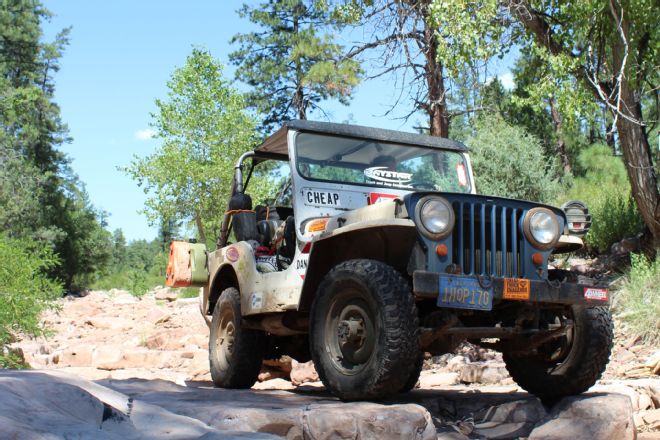
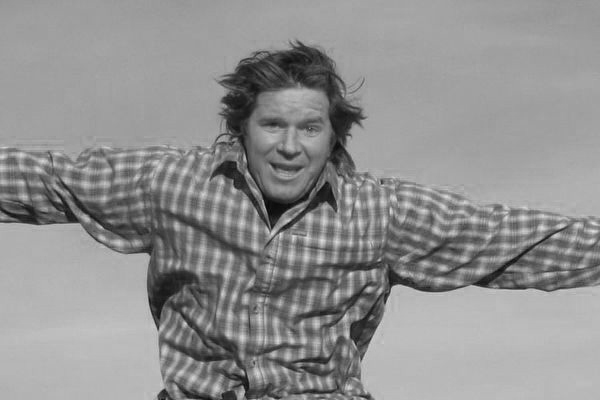 Fred Williams
Brand Manager, Petersen’s 4Wheel & Off Road
Photographers:
Joe Fernandez
Fred Williams
Brand Manager, Petersen’s 4Wheel & Off Road
Photographers:
Joe Fernandez
When the Ford F-350 dropped out for my Cheap Truck entry I needed a Plan B, and I found it in my shop. Actually I found it months ago in a junkyard, and it made its way to my shop. This 1950 Willys Jeep CJ-3A isn’t perfect, but for a 65-year-old vehicle it’s pretty good. Is this a viable option for a kid’s first 4x4? That depends on who you ask. My first vehicle was a Jeep CJ-5. Péwé and Verne Simons both also had Jeeps as their first vehicles—a GPW and CJ-7, respectively—so it should be obvious that a Jeep builds character and can lead to a well-suited adulthood in a dying magazine industry.
The problems arise when the youth of today don’t realize that this 65-plus-year-old 4x4 is not similar to a modern-day 4x4 besides the steering and driving wheels both being round. There’s no radio, no working outlet to charge your phone, no Wi-Fi, no plastic dash, no airbags, not much heat when you want it (but plenty when you don’t), dodgy brakes (as in you hit the brakes and start dodging left to right trying to stay straight), and a giant loud gaping hole in the muffler. Actually kids like loud; a quiet muffler would only be for old codgers who can’t hear well anyways! Go figure.
A flatfender Jeep is small, requires concentration (no goofing around on Facebook on your Iphoney thingy) while trying to keep this diminutive sport/ute on the asphalt, and can be the best thing you’ve ever driven in terms of fun. They all came factory with a manual transmission. Driving one is a dying skill kids need to learn. It helps drivers understand what is happening with their vehicle when they realize that engine rpm and wheel speed correlate. The small size makes a great starter vehicle for off-roading because you can fit in tight trails and follow your friends in their fancy-pants side-by-side UTVs then still drive it to school on Monday.
Also, the lack of a sufficient top means you get to enjoy the great outdoors, and aftermarket tops are really just a way to enjoy the great outdoors from just inside a plastic/vinyl bubble, which means you’ll be very popular on sunny days and get to ride by yourself on rainy or snowy days.
All of these attributes will make you a stronger person. Well, these attributes and the lack of power steering and power brakes will make you a stronger person for sure.
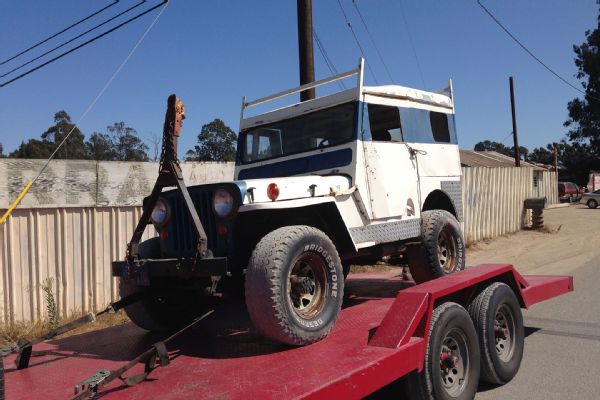 This 1950 Willys CJ-3A flatfender was sitting in a junkyard with a $1,700 price tag and I brought it home for $1,300. It didn’t run when I bought it, and yet I was enamored by the classic looks of a vehicle built before designers spent time with a giant clay model. Flatfender Jeeps were engineered as tools of war and modified for farming, long before they became recreational trail machines, and yet they started the off-roading pastime when GIs came home and started exploring the woods with surplus military MBs, GPWs (made by Ford) and then civilian Willys CJ-2As.
This 1950 Willys CJ-3A flatfender was sitting in a junkyard with a $1,700 price tag and I brought it home for $1,300. It didn’t run when I bought it, and yet I was enamored by the classic looks of a vehicle built before designers spent time with a giant clay model. Flatfender Jeeps were engineered as tools of war and modified for farming, long before they became recreational trail machines, and yet they started the off-roading pastime when GIs came home and started exploring the woods with surplus military MBs, GPWs (made by Ford) and then civilian Willys CJ-2As.
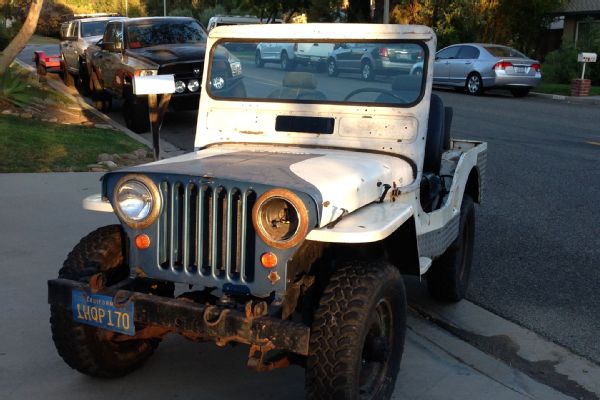 I wanted a flatfender for as long as I could drive, and this junkyard dog would become my first real wheeling flattie. Yes, I have a few others of various stages of modification (such as the Ultimate Summer Camp Jeep from UA 2015) but this ’3A is much closer to stock. However, it was upgraded over the years with a now rusty hard top, a rollbar built of pipe, a Warn (now Saturn) overdrive, and a built Buick V-6.
I wanted a flatfender for as long as I could drive, and this junkyard dog would become my first real wheeling flattie. Yes, I have a few others of various stages of modification (such as the Ultimate Summer Camp Jeep from UA 2015) but this ’3A is much closer to stock. However, it was upgraded over the years with a now rusty hard top, a rollbar built of pipe, a Warn (now Saturn) overdrive, and a built Buick V-6.
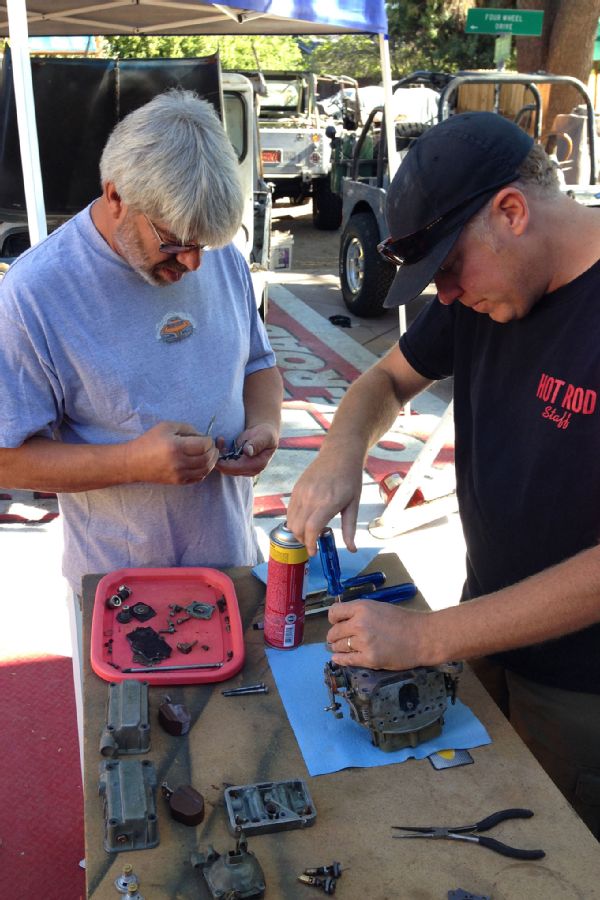 The Buick V-6 was an upgrade from a prior owner over the stock flathead four-cylinder. When I brought it home I found one cylinder full of water, not a good sign. I took it to the home of renowned Jeep
The Buick V-6 was an upgrade from a prior owner over the stock flathead four-cylinder. When I brought it home I found one cylinder full of water, not a good sign. I took it to the home of renowned Jeep 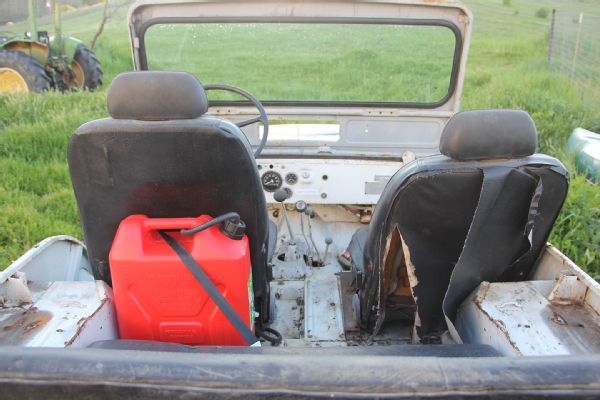 After we got the engine running (watch the episode if you want to learn more) I brought Ol’ Blue home and parked it in the corner. I wanted to do a few major upgrades, starting with a new fuel tank and seats. The factory seats had been replaced long ago by dismal high-back seats, which were not much better. The factory gas tank had rusted apart, and the fuel was coming from a plastic gas can.
After we got the engine running (watch the episode if you want to learn more) I brought Ol’ Blue home and parked it in the corner. I wanted to do a few major upgrades, starting with a new fuel tank and seats. The factory seats had been replaced long ago by dismal high-back seats, which were not much better. The factory gas tank had rusted apart, and the fuel was coming from a plastic gas can.
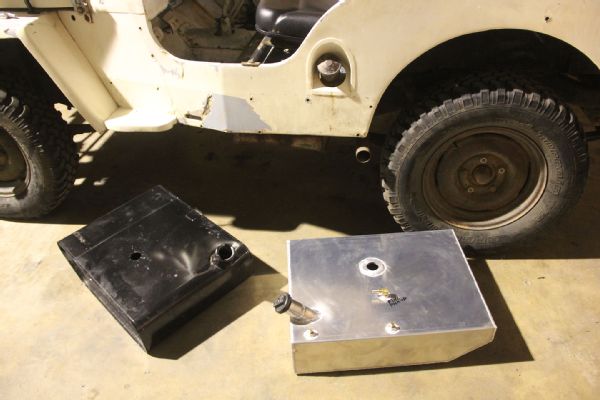 There are a variety of gas tank options for the Willys CJ owner. Omix-ADA offers a steel replacement tank for flatties for $211 and a poly tank for $348. Aqualu, maker of aluminum Jeep bodies, has made replacement tanks for Willys at around $275. These were all outside my budget. I found a used tank online for $50, and then I bought a few spare clear plastic fuel filters for $5 each in case it was full of rust and a bar of soap in case it leaked. I got lucky—the tank didn’t leak and wasn’t full of rust.
There are a variety of gas tank options for the Willys CJ owner. Omix-ADA offers a steel replacement tank for flatties for $211 and a poly tank for $348. Aqualu, maker of aluminum Jeep bodies, has made replacement tanks for Willys at around $275. These were all outside my budget. I found a used tank online for $50, and then I bought a few spare clear plastic fuel filters for $5 each in case it was full of rust and a bar of soap in case it leaked. I got lucky—the tank didn’t leak and wasn’t full of rust.
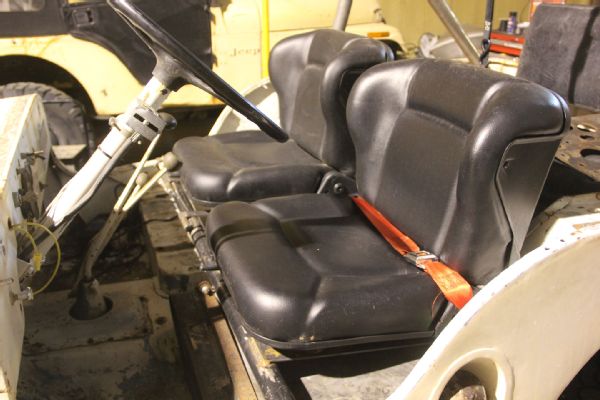 I wanted new seats but I couldn’t afford Jeeps seats because the frames alone are $288, and then you still need to add cushion at $100 each. Side bolsters on seats are great for off-roading as they keep you in place, but are a pain to climb over in a Jeep. My solution was a pair of replacement Toyota forklift seats from an online retailer. These were $200 each, have built in seatbelts, and have side bolsters, but only on the back so they are easy to get in and out of.
I wanted new seats but I couldn’t afford Jeeps seats because the frames alone are $288, and then you still need to add cushion at $100 each. Side bolsters on seats are great for off-roading as they keep you in place, but are a pain to climb over in a Jeep. My solution was a pair of replacement Toyota forklift seats from an online retailer. These were $200 each, have built in seatbelts, and have side bolsters, but only on the back so they are easy to get in and out of.
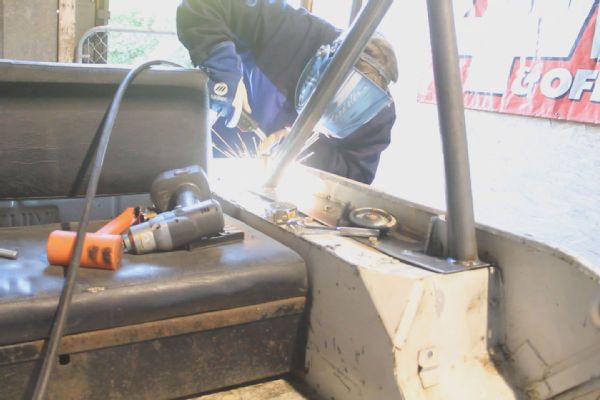 All that was left was mounting the seats and replacing the old pipe rollbar with something to keep me alive should the Jeep go belly-up. I scrounged metal, had a friend bend the main 2-inch-diameter hoop, and cut plates to weld it all to. Then I bolted the plates to the tub for the rollbar with massive body washers beneath and built cross-tubes above the in-floor toolbox and underseat gas tank to mount the seats to. I was using material I had lying around my shop, but have found 2x0.120-wall tubing at $55 for a 20-foot stick, and I figure I used no more than two sticks. If you add in some plate steel as well, I’m at about $200 for steel. And that leaves me $350 to cover the cost of cutting, grinding, drilling, and welding for the two downbars and crossbars. That’s not very much for a qualified fabrication shop, but it’s possible to do that yourself if you have access to the tools. I used my Miller MIG welder because the welds on a rollbar are pretty important as well as the notches, so take your time cutting and grinding those for a tight joint and get an experienced welder to do the job.
All that was left was mounting the seats and replacing the old pipe rollbar with something to keep me alive should the Jeep go belly-up. I scrounged metal, had a friend bend the main 2-inch-diameter hoop, and cut plates to weld it all to. Then I bolted the plates to the tub for the rollbar with massive body washers beneath and built cross-tubes above the in-floor toolbox and underseat gas tank to mount the seats to. I was using material I had lying around my shop, but have found 2x0.120-wall tubing at $55 for a 20-foot stick, and I figure I used no more than two sticks. If you add in some plate steel as well, I’m at about $200 for steel. And that leaves me $350 to cover the cost of cutting, grinding, drilling, and welding for the two downbars and crossbars. That’s not very much for a qualified fabrication shop, but it’s possible to do that yourself if you have access to the tools. I used my Miller MIG welder because the welds on a rollbar are pretty important as well as the notches, so take your time cutting and grinding those for a tight joint and get an experienced welder to do the job.
Where the Money Went
Vehicle purchase $1,300
Budget $2,015
Remaining $715
Modifications
Tune-up and tires $1,000
Fuel tank and filters $65
Forklift seats (2) $400
Rollbar fabrication and materials (est) $550
Total $2,015
Budget $2,015
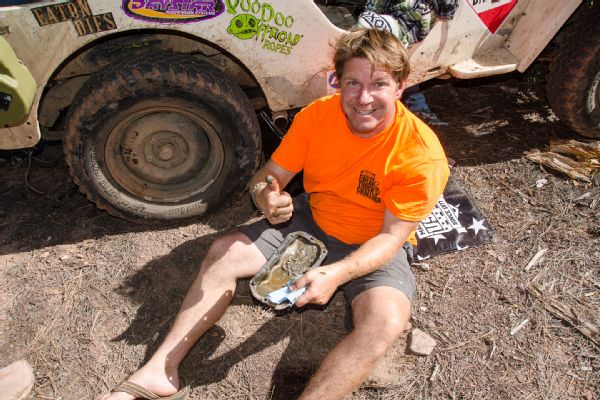
Now What?
My flatfender was awesome on Cheap Truck. The V-6 ran strong even after some time full of water, and the prior owner’s Saginaw manual steering conversion helped it steer, but at the end of the adventure my Spicer 18 transfer case spit bearings out and I took a trailer ride home. I like the Jeep as is, so I’ll just fix it, clean up the wiring, and keep driving it. I had added an old Warn off-road light I had lying around because the lights don’t work on the Jeep, but I never wired it in, so I will hook that up as well. If it were my only 4x4 I would swap in one-piece rear axleshafts and some custom chromoly front axleshafts, or upgrade the front axle to a Dana 30 and stuff both with selectable Eaton E-lockers. I may also sand off all the paint, not because I don’t like the paint but because it’s sprayed over an eighth of an inch of Bondo and I don’t like Bondo.